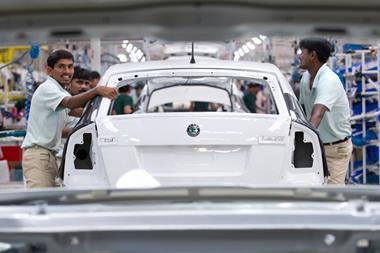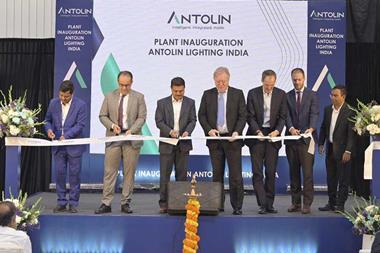Automation is advancing slowly in the Indian automotive sector – as is the faith of manufacturers in the country’s machine suppliers, as we discovered on a recent tour of OEMs and Tier suppliers
India is a vehicle market with unique qualities: a rapidly growing middle class who are well-informed on the latest trends in cars, trucks and motorcycles, combined with long model lifecycles and the belief that a new car must still be repairable anywhere in the country – by any able roadside mechanic – have created some bizarre vehicle segments that are particular to the region.

Other factors include slow and complex supply chains inland (for OEMs and suppliers), a somewhat laissez-faire attitude to business development by government agencies, and the rather slow adoption of automation by OEMs, resulting in many ergonomically-challenging and some downright dangerous tasks remaining manual and thus inefficient in many plants.
Labour unrest and the power of a new location
Certainly what is holding back some of the development of the auto industry in India is the government’s apparent lack of interest in assisting development, as Nitin Kulkarni, head of corporate planning, manufacturing at Tata Motors and a star speaker at the 2012 AMS India conference, told us. He talked of the company’s experiences with government intervention (or lack of it) in the dispute over the original Nano plant site in West Bengal: “We waited for the local administration to act and help us resolve our differences with the local political parties who were stirring up farmers and other small landowners who had sold their land to Tata for the plant site,” he said. “In the end we lost patience, and with just a week to go before the planned start of production, we pulled the whole plant and shipped it to Sanand, in Gujarat.”
The Nano has had a chequered history, not only in production sites but also in sales; far from the planned 15–20,000 vehicles per month that would have seen it make the company some real money, it has not reached much more than the present output of 8,000 per month; with these low sales figures, most industry watchers in India say Tata is not making money on the sub-compact.
Gujarat state is rapidly becoming a major automaking region in India; following Tata there is Ford, with a US$1 billion investment; Maruti Suzuki, India’s biggest car manufacturer, is building a plant in Mehsana, close to the Mundra port; and motorcycle group Hero (the largest twowheeler maker in the world) has also chosen the state for its fourth factory in India. PSA has taken a plot of land in the state for its first plant in India – a proposed $850 million investment – but its plans are on hold due to the financial situation in Europe.
Reliable power supplies, decent infrastructure and ports (by Indian standards), and the availability of educated labour are the other factors making the region attractive to OEMs and component makers. Indeed, 19 automotive suppliers are scheduling to build factories and train workers there just to supply Ford and these moves look like the start of a corporate ecosystem that could well attract other manufacturers.
Satkar Grewal, a senior manager at Maruti Suzuki says: “Other than Gujarat, states in India have a problem of reliable power supply; and the quality of the manpower [in Gujarat] is good plus it is close to the port, our own port.” Maruti’s operations have traditionally been focused in Haryana, while the other main Indian car-making hubs are Pune, in Maharashtra, and Chennai in southern Tamil Nadu where Ford, Hyundai, Renault-Nissan and Ashok Leyland have plants. Maharashtra has recently revised its tax structure to close a loophole whereby OEMs could sell their output to their dealer network and offset tax on sales within the region, making it less attractive to the industry Bucking the trend of moving to Gujarat is Beiqi Foton, the Chinese truck maker that is investing $305 million in a plant in Chakan, near Pune, in Maharashtra state. This comes on the back of the Chinese company’s stated intention to bring its full range of light, medium and heavy commercial vehicles to India, partly spurred by the Chinese government’s withdrawal of incentives.
Growing segments and a dearth of domestic machine makers
 The boom segment in India is SUVs and vehicle makers are gearing to supply the trend, as Nitin Kulkarni concurrs: “SUVs are the fastest growing sector in the country and at Tata we are planning to build more Land Rovers [and likely Range Rover models] in the country, using CKD and ultimately full production plants.” There is a similar story at Mahindra, whose XUV500 helped the automotive division show a 44 % rise in sales in the year ending March 2012, boosted in large part by the growing demand for dieselengined vehicles, in turn driven by rises in petrol prices over the last 12 months.
The boom segment in India is SUVs and vehicle makers are gearing to supply the trend, as Nitin Kulkarni concurrs: “SUVs are the fastest growing sector in the country and at Tata we are planning to build more Land Rovers [and likely Range Rover models] in the country, using CKD and ultimately full production plants.” There is a similar story at Mahindra, whose XUV500 helped the automotive division show a 44 % rise in sales in the year ending March 2012, boosted in large part by the growing demand for dieselengined vehicles, in turn driven by rises in petrol prices over the last 12 months.
While domestic OEMs are thriving and innovating new vehicles, what of the machinery makers in India? Tata’s Kulkarni says: “It is a little surprising that there are not more Indian machine builders, but a lot of customisation and modification is made on imported and transplant-produced machines here in India.” And some of this expertise is now being exported: Tata’s machinery division, Tata Technologies, is building custom lines for carmakers and tier suppliers, using its own and bought-in components, for customer projects in Indonesia and Burma.
 Vijay Kalra, senior vice-president of manufacturing operations at Mahindra, echoes Kulkarni’s sentiments. “When we looked for a paintshop builder for our plants, it came down to foreign suppliers, there was no realistic proposal from an Indian supplier; in the end we went with Yushin, a Korean company, and they have installed three lines for us in the last five years,” he reveals. On robots, Kalra has a similar tale: “We sent out our RFQs and finally settled on Fanuc as they have the best support network in India; we cannot have downtime due to the unavailability of spare parts and no Indian supplier could meet our needs.”
Vijay Kalra, senior vice-president of manufacturing operations at Mahindra, echoes Kulkarni’s sentiments. “When we looked for a paintshop builder for our plants, it came down to foreign suppliers, there was no realistic proposal from an Indian supplier; in the end we went with Yushin, a Korean company, and they have installed three lines for us in the last five years,” he reveals. On robots, Kalra has a similar tale: “We sent out our RFQs and finally settled on Fanuc as they have the best support network in India; we cannot have downtime due to the unavailability of spare parts and no Indian supplier could meet our needs.”
AGVs and other automated handing systems are making slow progress into India. Motorcycle maker Bajaj has integrated a Japanese Leopard AGV into its engine line; machined parts are loaded onto the AGV by hand and taken through a semi-hermetic door to a kitting area where sets are made up by hand for each engine. At first it seems odd that only one AGV is in use in a large plant but as Ashok Bhandari, assistant manager of administration at the Chakan, Pune plant explains: “Using the AGV means that no contamination from machining is transferred to the assembly line by humans; no swarf or cuttings, machining oils or dust is carried into assembly, where the engine parts must be absolutely clean.”
 I asked Bhandari about buying Indian-made equipment: “We use a lot of Fanuc and Makino equipment but, over the past seven years, India-made machining centres have improved enormously. These machines may not have the speeds of imported machines but, in terms of reliability and accuracy, they are good. We have no qualms about using India-made machines, such as PARI Robotics, a company which serves many automotive applications.”
I asked Bhandari about buying Indian-made equipment: “We use a lot of Fanuc and Makino equipment but, over the past seven years, India-made machining centres have improved enormously. These machines may not have the speeds of imported machines but, in terms of reliability and accuracy, they are good. We have no qualms about using India-made machines, such as PARI Robotics, a company which serves many automotive applications.”
Bajaj had always set great store in intensive training to minimise errors in assembly; it does not use errorproofing systems but relies on the intelligence and skill of its workforce. Bhandari says: “Our operators are all welleducated and will only stay on the line for about two years, they want to progress, here or at another company, so they are really dedicated and take great care in getting it right first time.”
Bajaj has about 15% turnover in line operators, who are mostly diploma engineers, but unusually, it encourages ‘churn’, with a target of 20% as it wants them to be ‘fresh’ as Bhandari explains: “We do not want people to lose their enthusiasm by staying on the assembly lines too long; we think five years is enough, then they can move on to more education or to become supervisors or managers within Bajaj. We would expect a worker to join us when they are 20 years old, and leave within five years.”
Powertrain plans at Renault-Nissan
AMS caught up with Senthilkumar Rathinam, head of powertrain process engineering at Renault-Nissan, who told us about the company’s model and engine plans. The carmaker will introduce the Duster in India in 18 months time, badging it as a Nissan, and he boasts of 30% of its bought-in parts being sourced in India. “We are keen to stimulate local sourcing, it is good for the industry here, and good for Renault-Nissan,” he says. “A new ‘A’ entry-level car will start production in 2014, the powertrain and body process for this is being developed here in India.” This car, which will be smaller than the Micra, will be badged as a Datsun; Rathinam spoke of it as being “Alto-sized” and it could also be made in Brazil and Russia if it is successful. Rathinam is very proud of India’s part in it: “If India shines in this project, I hope that all the production will stay here, but if the powertrain and body development that is done in India is a success, I guess we will be proud if it is made elsewhere also.”
The carmaker is ramping up engine casting and manufacture in India with a $128 million investment in its first foundry and machining centre in India, at its Oragadam plant. For the entry level car, the ‘A’ line, production will start at 300,00 upa and rise to 600,000 upa, if it supplies Russia and Brazil, and Rathinam says this could rise to 1 million upa if demand meets forecasts. He says an Indian machining centre maker, BFW, will be used, with Widmea fine boring machines for the cylinder blocks. Loading will be manual at first but automation will phase in as demand rises. “Balancing automation and labour is especially critical for a low-cost vehicle programme and we want to keep the staff on wherever we can, ” he explains. MAG will supply some 20 machining centres for the first 120,000 upa, with customised tool fixtures. While he is keen on Indian tooling companies, Rathinam says that for certain applications, imported equipment is the first choice: “We use Güdel India gantry loading gear for the heavy lifiting but our assembly side handling gear is from PARI and Titan; for example our full gearbox assembly line came from Titan.”
AMS travelled to Chennai to visit Ashok Leyland and view its new Neptune engine line; this is a medium-duty (160- 380hp) fully electronically governed engine, developed with AVL of Austria, which features in its U-Truck platform. Ashok Leyland uses Makino machining centres and Cleantech parts-washing gear for its in-house production of cylinder block, cylinder head, crankshaft and camshaft; other parts are bought-in, mainly from Indian suppliers. For the cam bore and head reaming operations, Indianmade Lokesh machines are used, and other operations are carried out on the Neptune, which is at low volume at present (22 engines per shift) in a special clean-room area. The main engine line at Ashok Leyland produces its H-series engine (H for the Hino-derived design), this line runs at 110 units per shift.
 Ashok buys raw crankshaft and axle forgings from China for full machining for some models of engine, and semifinished items from Bharat Forge in India.
Ashok buys raw crankshaft and axle forgings from China for full machining for some models of engine, and semifinished items from Bharat Forge in India.
C R Ravi, the company’s general manager of project planning summed up the spirit that we found on all our visits: “We have just bought a lot of Esskay milling machines for a new engine line at our Ennore plant and we will continue to buy from Indian machine makers – they are all making great strides towards building machines as good as the best in the world, and we will always support them where it makes good business sense.”






































